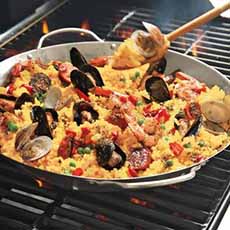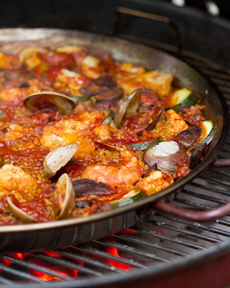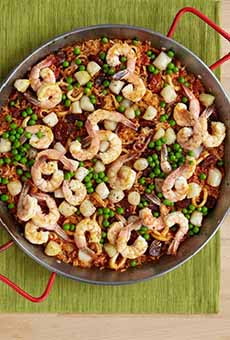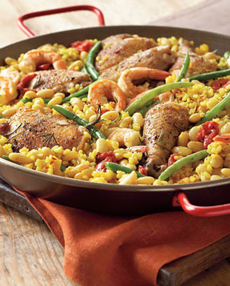Make Paella On The Grill
|
We love paella and don’t make it often enough. So when Fagor wrote to us about their paella pan and included a recipe (below) to make paella on the grill, our ears perked up. Before we get to the recipe, here’s a bit about paella, past and present. Paella (pronounced pie-AY-ya) originated in Valencia, a region on the Mediterranean (east) coast of Spain. It was originally a peasant dish, made by agricultural laborers who cooked a mixture of rice, snails, and vegetables in the fields. Cooked in a pan over an open fire. it was a communal dish, eaten directly from the pan with wooden spoons. Valencianos who lived closer to the coast added local eel plus butter beans (lima beans). Paella is the type of dish that lends itself to adding whatever you have on hand, so can change seasonally. Recipes thus evolved in many directions. The paella we know today—saffron rice mixed with chorizo, chicken, and seafood—did not evolve until the late 18th century, when living standards rose affording the use of more expensive ingredients—especially saffron, the world’s costliest spice. It’s easy to vary the ingredients to create any type of paella, including vegetarian and vegan recipes. But three main styles developed in the 19th century: Artichokes and tomatoes replaced runner beans in the winter. Spices included garlic, pimentòn (sweet paprika), rosemary, saffron, and salt. The dish was cooked in olive oil. The recipe continued to evolve as chorizo, green peas, olives, and roasted red pepper found their way into the dish. We’ve seen recipes with chopped chard or escarole, eggplant, fennel, mushrooms, olives, onion, piquillo chiles, red or green bell pepper, snow peas, tomatoes (fresh diced or roasted), and seasonal (spring asparagus and winter squash, e.g.). Some cooks garnish the top of the paella with sliced hard-boiled eggs and lemon wheels. The cook’s favorite ingredients were sure to be included. The chef at Soccarat, a group of tapas and paella restaurants in New York City, devised a paella menu that includes: |
 [1] Paella mixta on the grill. Mixta means both meat and seafood (photo © Sur La Table).
|
|
|
  *The word vegetariano does exist in Spanish, but there is some poetic license involved with the orchard reference. |
||
|
|
RECIPE: PAELLA ON THE GRILL
This recipe, sent to us by Fagor, takes about 40 minutes. Created by A Couple Cooks, can easily be made as a vegan dish. You can also add the traditional mixto ingredients, chicken thighs and sliced chorizo. Ingredients For 4 Servings |
|
|
Preparation 1. HEAT the grill to medium-high heat. Prepare the ingredients: Scrub the mussels or clams; place them in a bowl with the shrimp. Slice the zucchini and mushrooms; chop the cauliflower into bite-sized pieces. Place the vegetables in a bowl. 2. MINCE 4 cloves of garlic and put them in a small bowl with 3 tablespoons olive oil. In a medium bowl, place ½ cup tomato purée and 5½ cups broth; mix to combine. In another bowl, add 2 cups arborio rice, 1 pinch saffron, 2 tablespoons pimentón, 1 teaspoon kosher salt, and a good amount of fresh ground pepper. 3. ASSEMBLE the paella: Bring the bowls of ingredients and the paella pan to the grill. Prior to cooking, add about 15 briquettes to the fire to keep the temperature up. Place the pan on the grill and add the olive oil and garlic; cook for about 30 seconds. Add the vegetables; cook for about 2 minutes, stirring occasionally. Add the seafood; cook for about 2 minutes, flipping the shrimp once. Pour in the rice and spices so that they cover the pan. Add the broth and purée mixture and stir to combine. 4. COOK the paella for 20 to 30 minutes, until most of the liquid has evaporated. Cook uncovered on a charcoal grill or with the cover down on a gas grill. Make sure not to stir, since this is when the soccorat develops. (Editor’s note: Soccorat is the rice crust on the bottom of the pan, which some people find very exciting. We personally don’t like hard, crunchy rice). 5. CHECK to see that the rice on the bottom does not burn; it cooks fairly quickly. Remove the pan from the heat and let sit for about 5 to 10 minutes to cool. Why not make paella in a roasting pan or other vessel you already have? You can, of course; but a paella pan is specifically designed for seamless heat conduction and retention. Fagor’s, with a heavyweight and enamel-on-steel design, is a great heat conductor on the grill, oven, or stovetop. You can buy it Fagor Paella Pan or at retailers like Bed, Bath & Beyond. Be sure to get the 15-inch size. With a dish like paella, you want to make as much as you can and enjoy the leftovers. A paella pan is a versatile piece of cookware that can also be used to make: |
||


